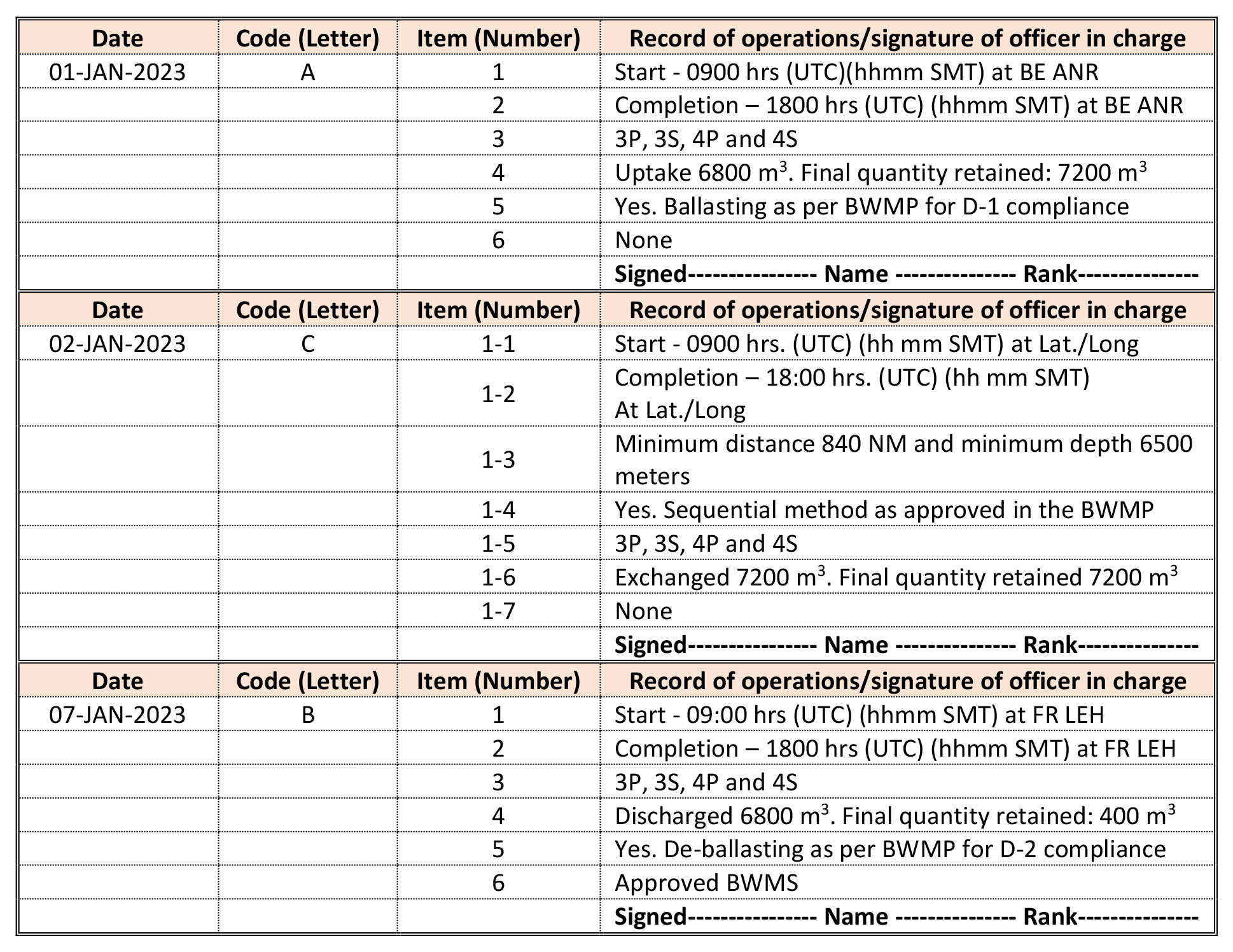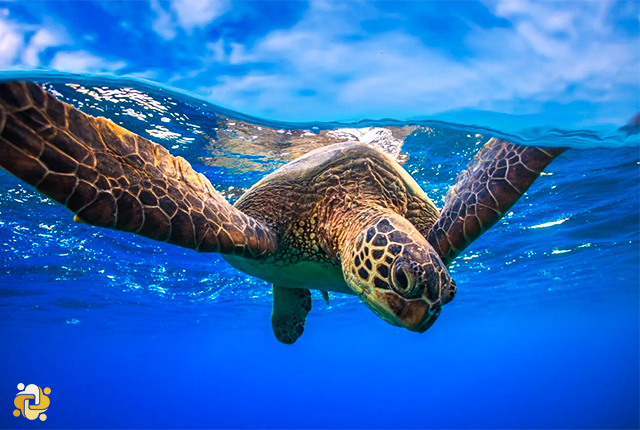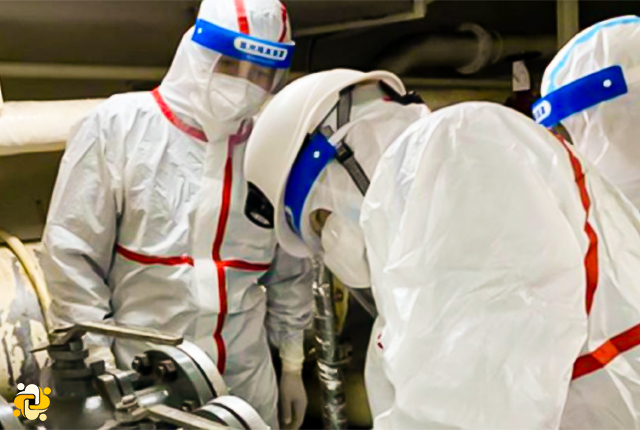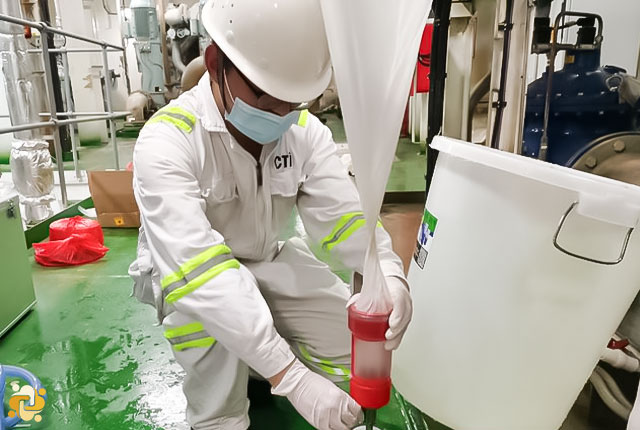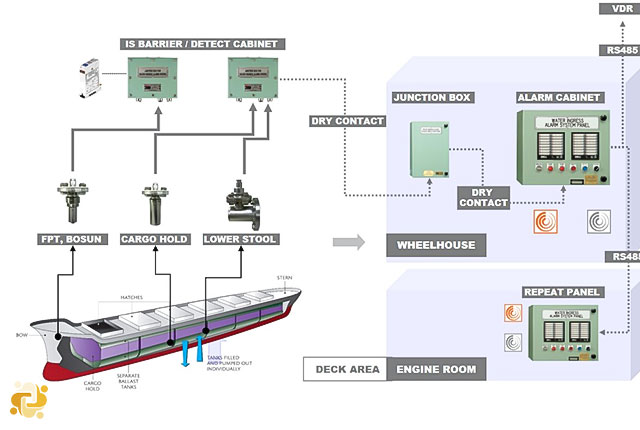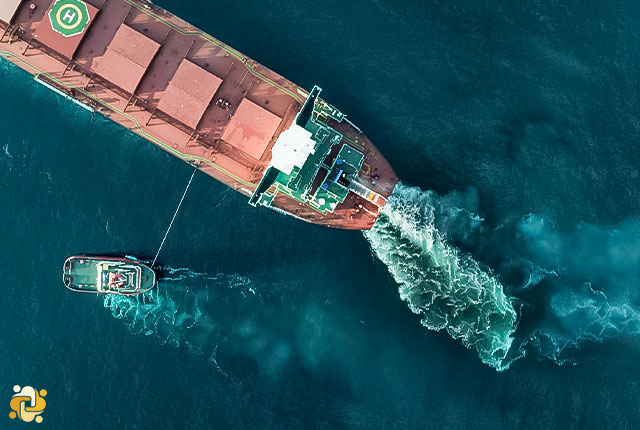
Guidance on ballast water record-keeping and reporting
2023-08-26 11:24
Introduction
The Marine Environment Protection Committee, at its eightieth session (3 to 7 July 2023) approved the Guidance on ballast water record-keeping and reporting to assist in bringing clarity to the record-keeping and reporting process under the BWM Convention, including guidance on completing the Ballast Water Record Book. This BWRB format will enter into force on 1 February 2025.
Regulation B-2 of the BWM Convention establishes mandatory requirements for maintaining a BWRB on board the ship, and appendix II of the Annex to the Convention specifies the information that must be included.
The BWRB may be inspected in the port or offshore terminal of a Party by officers duly authorized to inspect the ship for the purpose of determining compliance with the Convention. The following sections explain when to record operations in the BWRB, how to record these operations (including standardized formats that should be used for smooth record-keeping and inspections) and how the records should be stored.
How to record operations in the Ballast Water Record Book?
When making entries, write the date in dd-MMM-yyyy format (e.g. 01-JUN-2022). If the operations cross over the dates, then the entry should be made after completion of the operation and the start date can be mentioned as: - Start 1900 hrs (UTC) (hhmm SMT) on 01-JAN-2023 and Completion at 0100 hrs (UTC) (hhmm SMT) on 02-JAN-2023.
Enter the appropriate code and item number in the respective columns.
Enter all times using the Coordinated Universal Time (UTC) and Ship's Mean Time (SMT).
Record the ballast tank nomenclature as per the diagram corresponding to the Ballast Water Management Plan that forms a part of the Ballast Water Record Book.
Enter the port names using the proper standardized UN/LOCODE. If the UN/LOCODE is not available, or an offshore terminal or anchorage area is entered, write out Port Name and Country in full. No abbreviation should be used.
Enter the location position in the degrees, minutes and seconds format (example: Lat: 00 00.00 N/S, Long: 000 00.00 E/W).
Under the item "Ballast water treatment method" enter any treatment applied to the water during the specific operation being recorded. No prior treatment or intended future treatment should be recorded. If more than one method applies (e.g. partial treatment) then multiple entries should be made, each pertaining to the relevant volume. The following notations should be used:
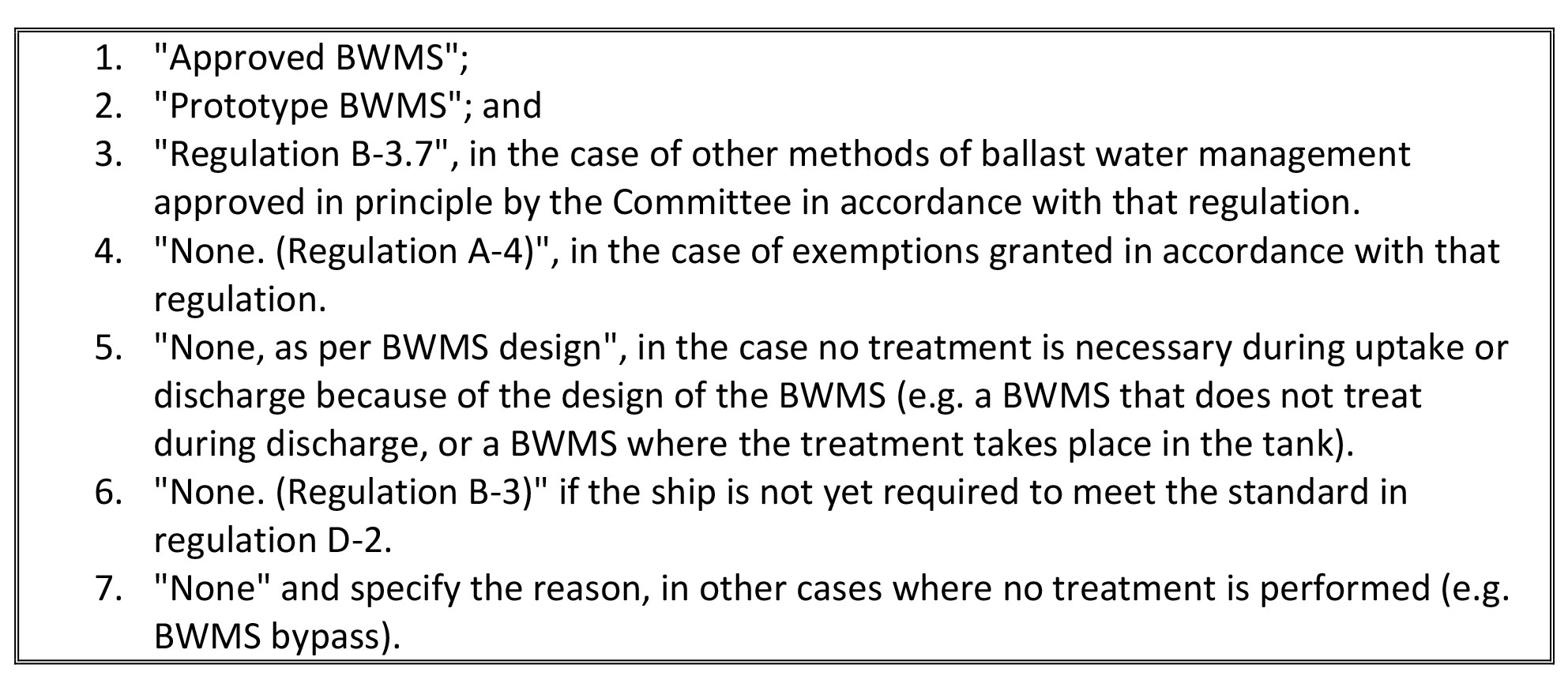
There should not be blank lines between successive entries. In the case of a ship subject to equivalent compliance under regulation A-5 that is required by its Administration to keep records of each ballast water operation, the information specified in this article should be taken into account.
The entries in the Ballast Water Record Book shall be in a working language of the ship. If that language is not English, French or Spanish, the entries shall contain a translation into one of those languages. When entries in an official national language of the State whose flag the ship is entitled to fly are also used, these shall prevail in case of a dispute or discrepancy. (regulation B-2.5)
Each entry shall be signed by the officer in charge of the operation concerned and each completed page shall be signed by the master. (regulation B-2.5) Incorrect entries should be struck through with a single line in such a way that the wrong entry is still legible. The incorrect entry should be signed and dated and followed by the correct entry. Entries pertaining to an earlier missed operation should be completed.
Storage of information
The Ballast Water Record Book shall be maintained on board the ship for a minimum period of two years after the last entry has been made and thereafter in the Company's control for a minimum period of three years. (regulation B-2.2) The Ballast Water Record Book shall be kept readily available for inspection at all reasonable times and, in the case of an unmanned ship under tow, may be kept on the towing ship. (regulation B-2.4)
Officers duly authorized by a Party may inspect the Ballast Water Record Book on board any ship to which this regulation applies while the ship is in its port or offshore terminal, and may make a copy of any entry, and require the master to certify that the copy is a true copy. Any copy so certified shall be admissible in any judicial proceeding as evidence of the facts stated in the entry. The inspection of a Ballast Water Record Book and the taking of a certified copy shall be performed as expeditiously as possible without causing the ship to be unduly delayed. (regulation B-2.6)
Sample entries in the ballast water record book
Code A - When ballast water is taken on board (ballasting operation)
When ballast water is taken on board from the aquatic environment (ballasting operation):
- Start time and location (port of uptake or latitude/longitude)
- Completion time and location (port of uptake or latitude/longitude and minimum depth of water during uptake)
- The identity of the tanks affected
- Estimated volume of uptake and final total quantity retained in cubic metres
- Whether conducted in accordance with the approved Ballast Water Management Plan
- Ballast water treatment method

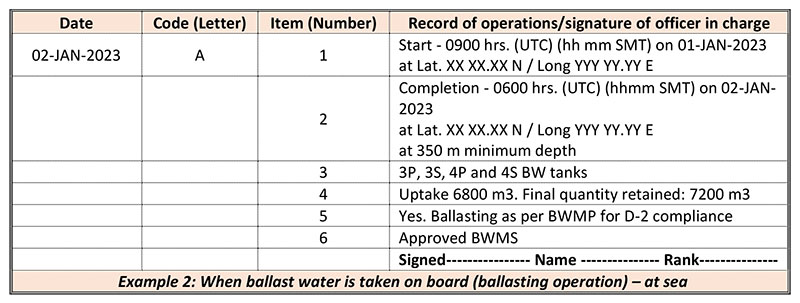
A ship required to meet the D-1 standard that loads ballast water without treatment in accordance with the BWMP should record "Yes. Ballasting done as per the BWMP for D-1 compliance" in item 5 and "None" in item 6. When the ship later carries out a ballast water exchange, this should be recorded under code C.
The examples 1 and 2 consider the new intake water of 6,800 m3 taken in tanks having existing treated water of 400 m3. Mixing of treated water with untreated water will result in the full load being considered as unmanaged.
In case the ship has to take in unmanaged ballast water, item 5 should state "No", item 6 should state "None" and the reason should be given.
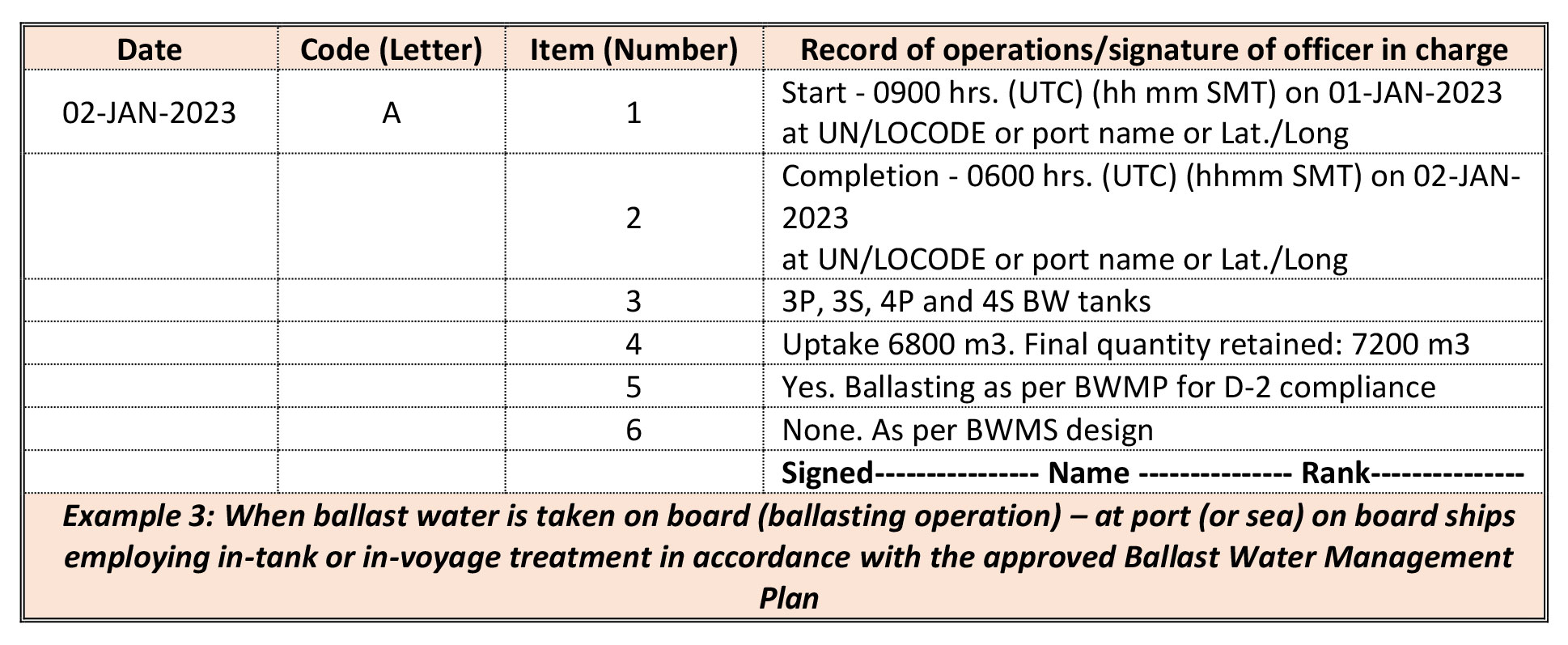
BWMS employing "in-tank" treatment load in ballast directly into the tank without any treatment. At the point of uptake, entry to be made as per example 3. Item 6 must state "None. As per BWMS design". Subsequently the ship must make entry as per example 10 when carrying out the in-tank or circulation using code C-2.
Code B - When ballast water is discharged into the aquatic environment (de-ballasting operation)
- Start time and location (port of discharge or latitude/longitude)
- Completion time and location (port of discharge or latitude/longitude and minimum depth of water during discharge)
- The identity of the tanks affected
- Estimated volumes of discharge and final total quantity retained in cubic metres
- Whether conducted in accordance with the approved Ballast Water Management Plan
- Ballast water treatment method


For a D-1 certified ship, item 5 to be entered as "Yes. D-1 compliant" and item 6 to be entered as "No".
Ships employing single pass treatment system (only on uptake) with no treatment during de-ballasting are to record "None, as per BWMS design" in item 6.
Ships de-ballasting water managed under the contingency plan of the approved BWMP to record as per example 7.

For a D-1 certified ship, in case the ship has not carried out the exchange, item 5 to be recorded as "No." and item 6 as "None. [regulation B-3]".
For a D-2 certified ship, in the event of discharge of semi / untreated water where the approved BWMP process is not followed, the de-ballasting event must be recorded with item 5 entered "No." and item 6 entered as "None" and state the reasons.
Further, entry using code (F) or code (H) is required to be made (as applicable) preceding the above example 6 entry, stating the conditions leading to non-compliant discharge.

For a D-2 certified ship, only in case the ship has implemented contingency plan as per approved BWMP, item 5 to be recorded as "Yes. As per approved contingency plan" and item 6 as "Approved BWMS" (if applicable to the contingency plan procedure adopted).
Code C - Whenever ballast water is exchanged, or treated in-tank or treated through internal circulation
C-1: Ballast water exchange
- Start time and location (latitude/longitude)
- Completion time and location (latitude/longitude)
- Minimum distance from the nearest land and minimum depth of water during the exchange or, if applicable, identify the designated exchange area in accordance with regulation B-4.2
- Whether conducted in accordance with the Ballast Water Management Plan and state the ballast water exchange method (sequential or flow-through or dilution) used
- The identity of the tanks affected
- Total quantity exchanged and final total quantity on board in cubic meters
- Treatment method for the incoming ballast water
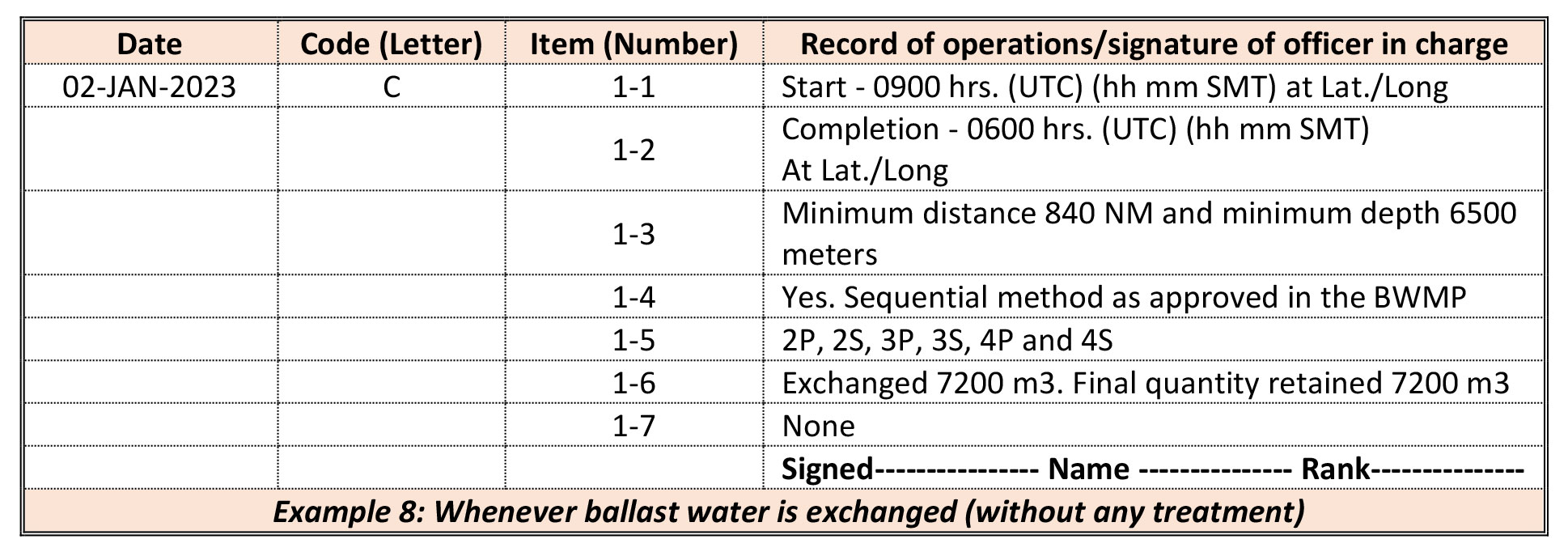
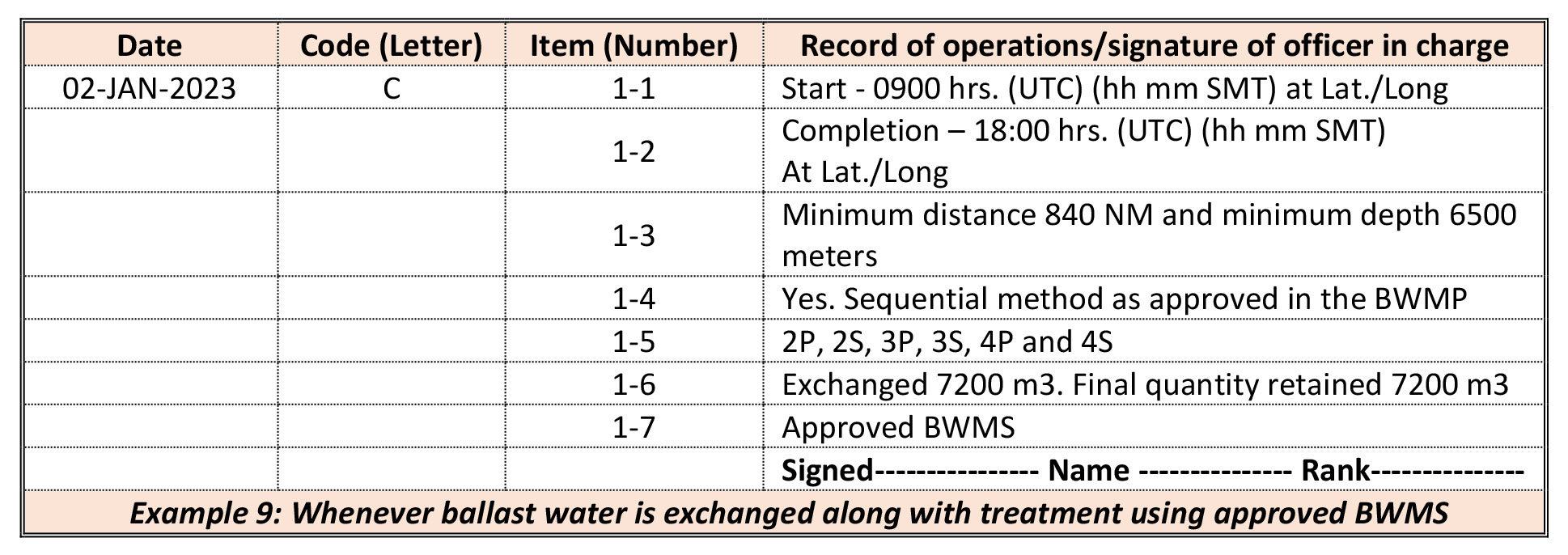
The stated exchange method (dilution/sequential/flow-through) must be as per the approved Ballast Water Management Plan. The exchange along with treatment (BWE+BWT), if carried out as per the approved BWMP contingency plan, must be recorded using example 9 and if applicable reported to the concerned authorities prior to discharge of this water.
In case of carrying out exchange at a designated area, state the "area name or Lat / Long" under item 1.3 and enter "designated area in accordance with regulation B-4.2" under item 1.4.
In the event the ship is unable to carry out exchange owing to safety or operational issues, entry has to be made as per example 26.
In case of a flow-through or dilution ballast water exchange as per approved Ballast Water Management Plan item 1.4 should state "yes flow-through or dilution (as appropriate) method (as approved in Ballast Water Management Plan)" and under 1.6 enter the total quantity exchanged and final quantity retained (example: "exchanged 22000 m3 retained 7200 m3")
C-2: Ballast water internal circulation for treatment or in-tank treatment
- Start time
- Completion time
- The identity of the tanks affected (identifying source and destination tanks if applicable)
- Total quantity treated (through circulation or in tank) in cubic meters
- Ballast water treatment method

The above entry is applicable to the ships which circulate the water in the ballast tanks through the BWMS to achieve treatment. In such case there is no fresh intake or release of ballast water.
Ships taking in water directly (bypassing BWMS) and subsequently carrying out treatment in tank or in voyage as per BWMP, are required to make entry as per example 3 after uptake and as per example 10 when the treatment of this water is carried out.
Anti-heeling tank automatic operations of transfers of water for the purpose of list correction are not to be recorded under code C.
The internal transfers between a set of ballast tanks having same quality of water (either managed or unmanaged) for which entries have already been made under code A or managed under code C are not to be recorded.
In case of water being transferred into a tank not accounted under A-3, C 1.5 or C 2.3, entry is required to be made under code C-2 with C 2.3 capturing the required details.
Code D - Uptake or discharge of ballast water from/to a port-based or reception facility
- Start time and location of uptake/discharge (state facility name)
- Completion time
- Operation carried out (whether uptake or discharge)
- The identity of the tanks affected
- Total quantities in cubic meters and final quantity retained on board
- Whether conducted in accordance with the approved Ballast Water Management Plan
- Onboard ballast water treatment method

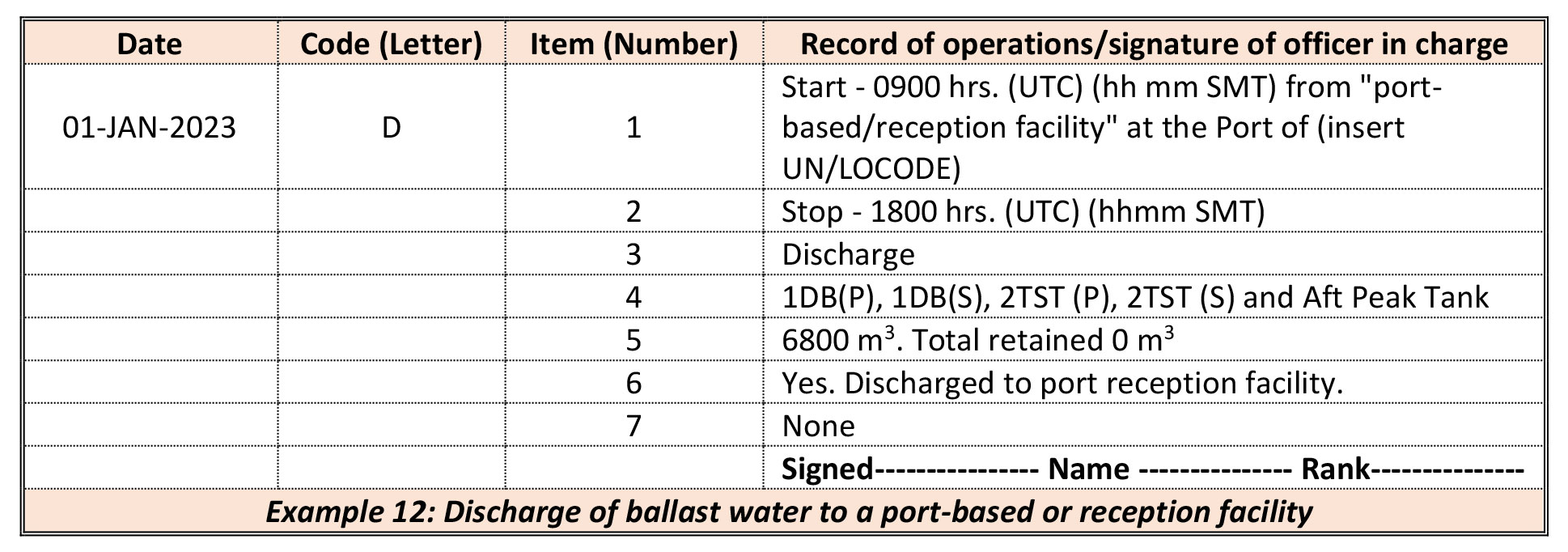
The ship taking in ballast water from the port facility which is treated by the onboard BWMS prior to filling the ballast tanks is to enter item 7 as "Yes, approved BWMS" in example 11.
The documents concerning the uptake / discharge of ballast water provided by the port-based or reception facility must be attached to the BWRB and must be readily available for inspection.
Code E - Accidental discharge/ingress or other exceptional uptake or discharge of ballast water
- Start time and location of ingress/uptake/discharge (port name or latitude/longitude)
- Completion time
- Operation carried out (whether ingress, uptake or discharge)
- The identity of the tanks affected
- Total quantity of ballast water in cubic meters
- State the circumstances of ingress, uptake, discharge or loss, the reason thereof, any treatment method used and general remarks



Accidental ingress or discharges are occurrences without human initiation. Water ingress or discharge (escape) due to collision, grounding, structural failures, valve or machinery failures are to be recorded under code E.
Exceptional uptake or discharge are human initiated procedures undertaken in exceptional circumstances for the safety of the ship and prevention of pollution. Intake of shore-supplied untreated water into ballast tanks at a dry dock facility for the purpose of undocking of a ship should be considered as exceptional circumstance and entry recorded under code E.
Code F - Failures and in-operabilities of the ballast water management system
- Time and location (port name or latitude/longitude) of failure of the ballast water management system
- Operation carried out (state whether uptake or discharge)
- Description of the issue (e.g. kind of alarm or other description of circumstances)
- Time and location (port name or latitude/longitude) when the ballast water management system has been made operational

 Failures and in-operabilities include malfunctions, shutdowns or critical alarms indicating a failure of the ballast water management system which may indicate non-compliance with the D-2 standard (except routine information and warnings). In case the BWMS failure is not rectified immediately, the entry using code F / item 4 is to be made on the date when the BWMS is made operational. In the event of failure of the BWMS during ballasting or de-ballasting, the entry under code A or code B must be followed up by code F entry as per example 17.
Failures and in-operabilities include malfunctions, shutdowns or critical alarms indicating a failure of the ballast water management system which may indicate non-compliance with the D-2 standard (except routine information and warnings). In case the BWMS failure is not rectified immediately, the entry using code F / item 4 is to be made on the date when the BWMS is made operational. In the event of failure of the BWMS during ballasting or de-ballasting, the entry under code A or code B must be followed up by code F entry as per example 17.
Inoperability of the BWMS due to challenging water conditions is required to be recorded under code F items 1, 2 and 3 with remark in item 3 clearly stating the alarms which are triggered owing to challenging water conditions.
Code G - Ballast tank cleaning/flushing, removal and disposal of sediments
- Time and ship's location on commencement of ballast tank cleaning/flushing, removal or disposal of sediments (port name or latitude/longitude)
- Time and ship's location on completion of ballast tank cleaning/flushing, removal or disposal of sediments (port name or latitude/longitude)
- Tank(s) identification (name of the ballast tanks as per the Ballast Water Management Plan)
- Discharge or disposal to a reception facility (state quantity in cubic meters and name of the facility)
- Disposal or discharge to the aquatic environment as per Ballast Water Management Plan (state quantity in cubic meters, minimum distance from the nearest land in nm and minimum depth of water in meters)


Sediment disposal receipt provided by shore/port reception facility or dry dock facility must be attached to the BWRB and must be available for inspections. In case of flushing of a tank with treated water, operation to be recorded under code G items 1, 2, 3 and 5 with comments in 5 stating that treated water was used to flush the tank.
Code H - Additional operational procedures and general remarks





BWMS failures are recorded under code F. In case of reporting to flag or port State, above entry to be recorded and, if operations subsequently carried out as per contingency plan or as per advice from port/flag State, same to be recorded under applicable code/item.

This entry is to be followed by the entry pertaining to the missed operation. The date 1 to be entered corresponding to the original date of operation and subsequent entry date 2 to be the current date.

This entry is to be made for safety (bad weather) or operational related issues (e.g. ship's route does not pass through areas where distance from nearest land is always more than 50 nm and / or 200 m depth or a designated BWE area).
In example 27, we discuss two sequential scenarios in relation to treatment or exchange of ballast water.
Example 27, Scenario 1: Uptake and discharge of ballast water for a ship subject to regulation D-2
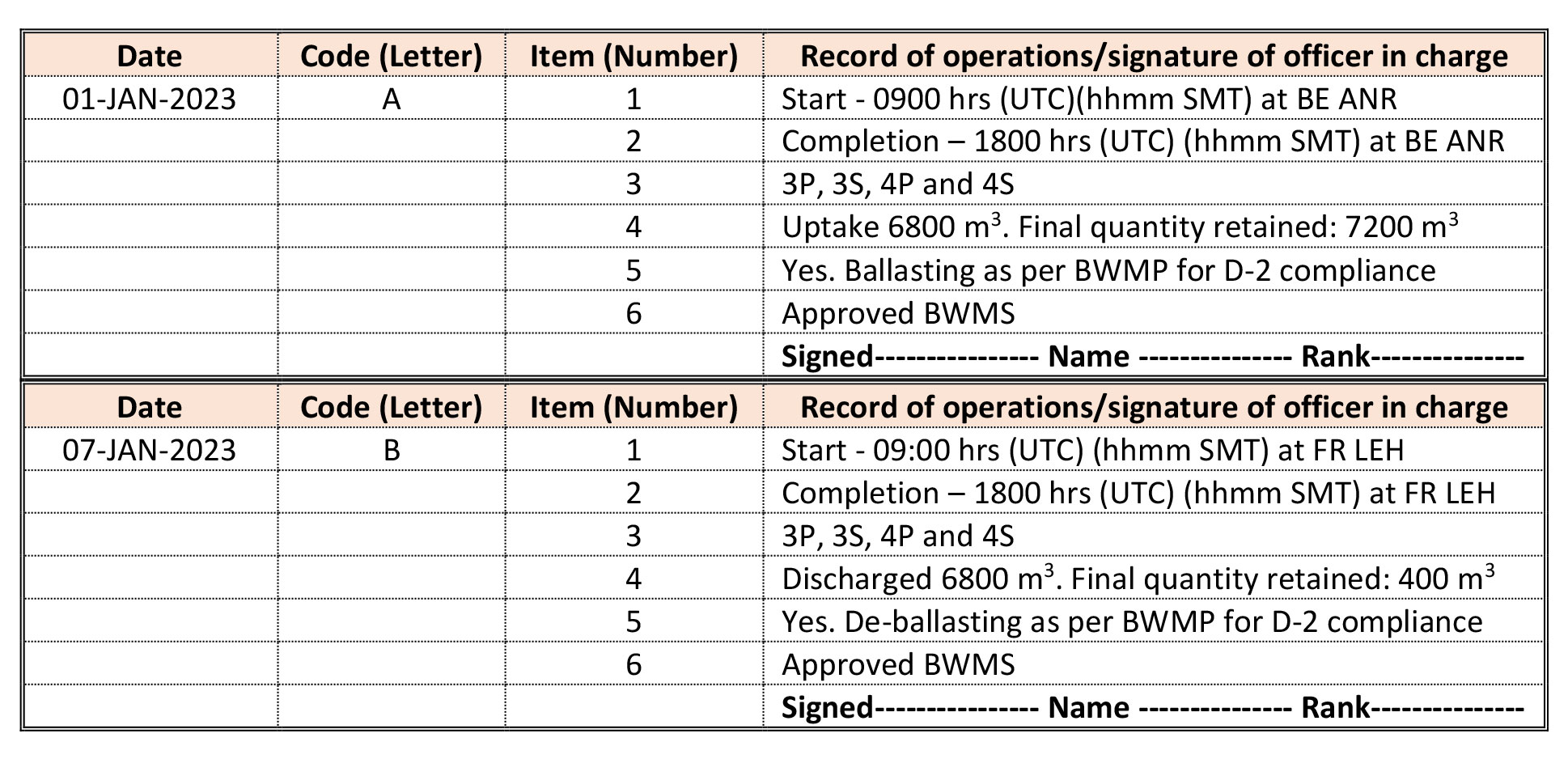
Example 27, Scenario 2: Uptake, exchange and discharge of ballast water for a ship subject to regulation D-1
